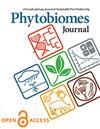Passaging phyllosphere microbial communities develop suppression towards bacterial speck disease in tomato
IF 3.3
3区 生物学
Q2 MICROBIOLOGY
引用次数: 3
Abstract
Microbial community-based disease management approaches have the potential to substitute or combine with currently employed strategies. Suppressive soils are great examples of microbial communities that suppress soilborne plant disease after severe outbreaks and are maintained over multiple years or crop cycles. While there are many suppressive soil examples, to our knowledge, there are no descriptions of disease suppressive phyllosphere communities. Therefore, we investigated whether a phyllosphere microbial community could be developed through a selective passaging method to suppress disease using the model pathosystem of Pseudomonas syringae pv. tomato (Pto) and tomato. Field tomato phyllosphere microbial communities were recovered, and spray transferred to greenhouse tomato plants, after which were inoculated with Pto. Disease severity was visually estimated, and the microbial communities were recovered to be independently applied to the next passage. Overall, greenhouse passaging resulted in an increase in disease severity for all passage lines from the initial passage, which peaked at passage 4-5, followed by a sharp decline until passage 9. The disease severity at passage 9 was also significantly lower than a non-passaged Pto only comparison. Heat-treatment of passage 9 communities resulted in elevated disease severity over several subsequent passages in the growth chamber, whereas the untreated community maintained low disease. Community-only passage lines (without Pto inclusion during passaging) did not show disease suppression after subsequent pathogen introduction. This work presents an experimental approach to develop phyllosphere microbial communities in the presence of a phytopathogen to enrich for a low disease phenotype and results in maintained disease suppression.传代根层微生物群落对番茄细菌性斑点病有抑制作用
以微生物为基础的疾病管理方法有可能替代或结合目前采用的策略。抑制性土壤是微生物群落在严重爆发后抑制土传植物疾病并维持多年或作物周期的好例子。虽然有许多抑制土壤的例子,但据我们所知,没有对抑制疾病的层圈群落的描述。因此,我们以丁香假单胞菌pv为模型病理系统,研究是否可以通过选择性传代的方法建立层球微生物群落来抑制疾病。番茄(Pto)和番茄。恢复田间番茄叶层微生物群落,并将其喷雾转移到温室番茄植株上,接种Pto。目视估计疾病严重程度,并恢复微生物群落,独立应用于下一传代。总体而言,温室传代导致所有传代系的疾病严重程度从初始传代开始增加,在4-5传代达到顶峰,随后急剧下降,直到9传代。第9代的疾病严重程度也显著低于未传代的Pto组。在生长室中,对第9代的群落进行热处理,导致其疾病严重程度在随后的几代中升高,而未经处理的群落则保持较低的发病率。只有群落的传代系(传代过程中不包含Pto)在随后的病原体引入后没有表现出疾病抑制。这项工作提出了一种实验方法,在植物病原体存在的情况下发展根圈微生物群落,以丰富低疾病表型并导致持续的疾病抑制。
本文章由计算机程序翻译,如有差异,请以英文原文为准。
求助全文
约1分钟内获得全文
求助全文

 求助内容:
求助内容: 应助结果提醒方式:
应助结果提醒方式:


